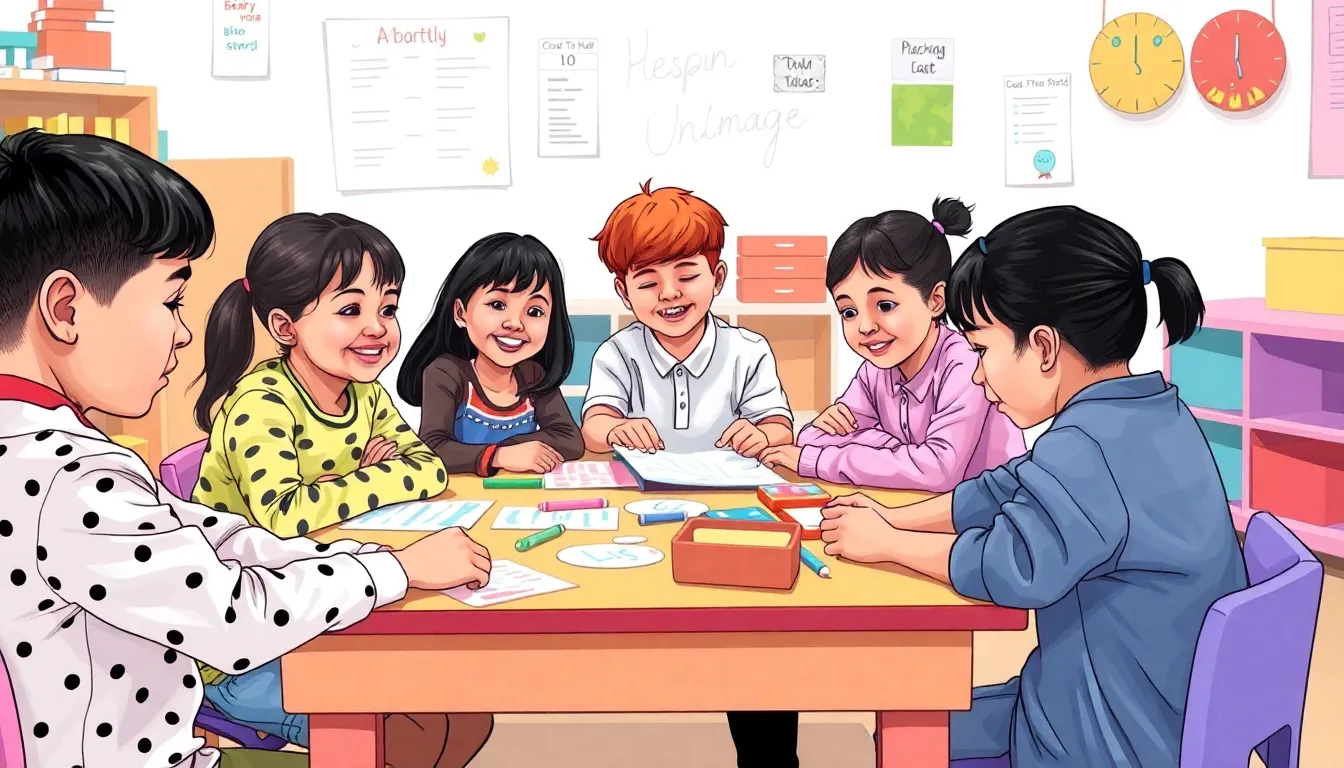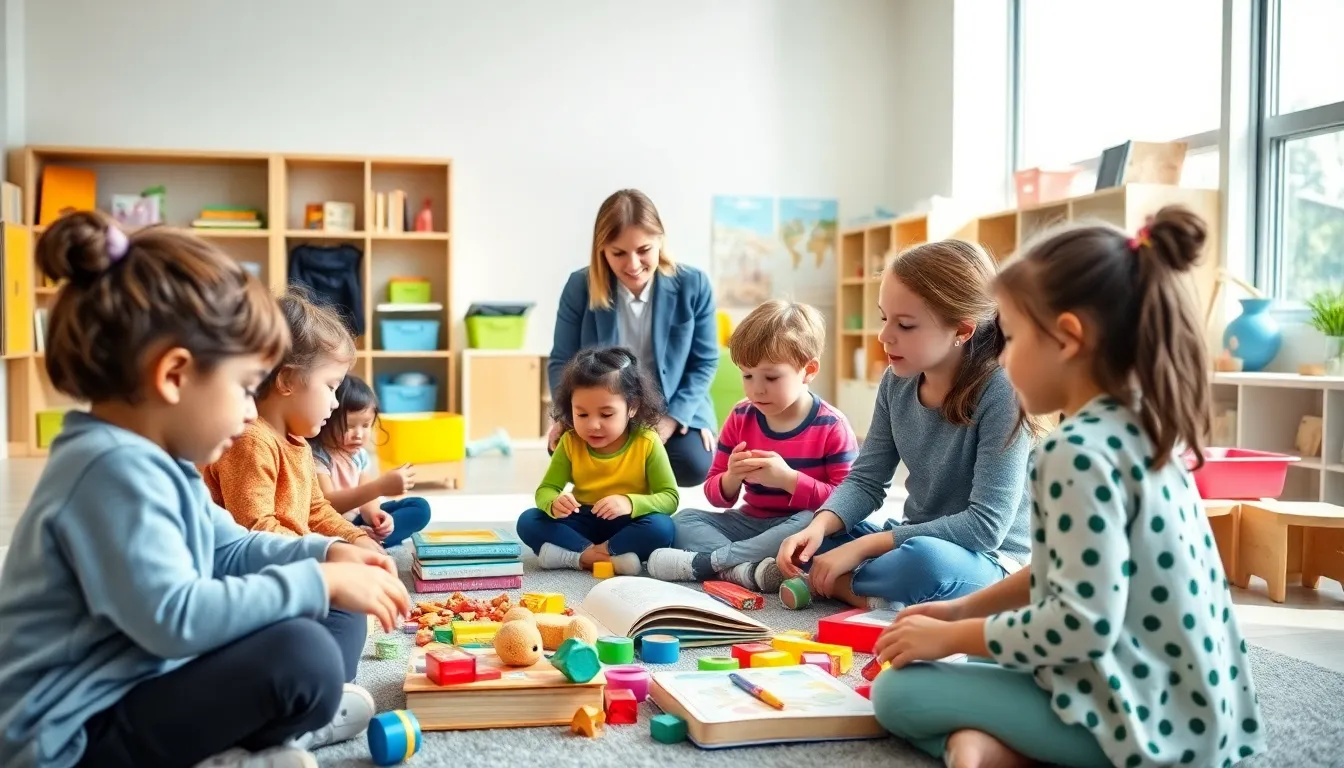Table of Contents
ToggleImagine a world where toddlers chatter in multiple languages like seasoned diplomats. That’s the magic of language immersion for children. It’s not just about learning a new tongue; it’s about unlocking a treasure chest of cognitive benefits, cultural awareness, and social skills. Who knew that the key to a child’s future could be found in a playful game of “Simon Says” en español?
In today’s global society, raising bilingual or multilingual kids isn’t just a trend; it’s a superpower. Language immersion programs offer kids the chance to dive headfirst into new languages, making learning feel like an adventure rather than a chore. So, if you want your little ones to navigate the world with confidence and flair, it’s time to consider the wonders of language immersion. After all, who wouldn’t want their child to order ice cream in Italian while charming the socks off everyone around them?
Understanding Language Immersion Children
Language immersion children thrive in environments where exposure to a second language occurs naturally. Immersion programs place kids in settings where they hear and speak another language daily. Often, educators use this technique to integrate language learning with academic subjects, enhancing both language skills and overall knowledge.
Cognitive development significantly benefits from language immersion. Research shows that bilingual children excel in problem-solving tasks and demonstrate higher levels of creativity. Notably, these cognitive advantages extend into adulthood, aiding in career prospects.
Social skills also see improvement among language immersion children. They develop better communication abilities due to regular interactions in diverse linguistic contexts. Engagement with peers from various backgrounds fosters empathy and cultural awareness, essential traits in today’s interconnected world.
Participation in language immersion programs correlates with increased cultural understanding. Exposure to different traditions and practices broadens a child’s perspective. Appreciation for cultural diversity serves as a key component in nurturing open-minded individuals.
Parents often notice enhanced self-confidence in their children involved in language immersion. Mastering a language creates a sense of achievement, encouraging kids to take on new challenges. It promotes resilience and adaptability, crucial traits for success in an ever-changing environment.
Selecting the right immersion program is vital for optimizing learning outcomes. Parents should research various options and find programs that align with their child’s needs and interests. Support from educators and caregivers plays a crucial role in fostering a positive learning experience that can last a lifetime.
Benefits of Language Immersion

Language immersion offers numerous advantages for children, significantly impacting their cognitive and social skills while nurturing a love for languages.
Cognitive Development
Cognitive growth flourishes in language immersion settings. Engaging with a second language boosts problem-solving skills and enhances creativity. Bilingual children outperform their monolingual peers academically. Research indicates a strong link between language exposure and improved executive functioning. Children who participate in immersive language learning show greater adaptability and improved multitasking abilities. They also develop critical thinking skills, as navigating multiple languages encourages flexible thinking. Studies reveal that these cognitive advantages persist into adulthood, positively influencing career opportunities.
Social Skills Enhancement
Social skills see notable improvement in children enrolled in language immersion programs. Interacting with peers from diverse backgrounds fosters empathy and communication skills. Daily immersion facilitates authentic conversations, promoting confidence in social settings. Children learn to appreciate cultural differences, equipping them for a globally connected world. These programs also encourage teamwork and collaboration, as language learners often work together on projects. Engagement in various linguistic environments nurtures respect for diversity, reinforcing positive social interactions. Regular practice helps children articulate thoughts and feelings more effectively, strengthening their ability to connect with others.
Challenges Faced by Language Immersion Children
Language immersion children encounter several challenges that can affect their overall learning experience. These challenges often stem from navigating complex linguistic environments.
Language Proficiency Anxiety
Language proficiency anxiety commonly arises among immersion students. They may feel pressure to perform well in a language they are still mastering. Increased expectations from parents and educators can exacerbate this anxiety. The fear of making mistakes might discourage participation in class discussions or social interactions. Regular practice in a supportive environment can help mitigate these feelings. Engaging activities that reinforce confidence in language skills will improve their comfort level in using the new language.
Cultural Identity Issues
Cultural identity issues often present challenges for language immersion children. Straddling two or more cultures can lead to confusion regarding their own identity. Some children may feel isolated from peers who do not share their bilingual experience. They might struggle to balance their home culture with the culture associated with the second language. Encouraging open dialogue about these feelings helps children navigate this complex landscape. Supporting multicultural experiences fosters a sense of belonging and strengthens their understanding of diverse identities.
Effective Strategies for Supporting Language Immersion
Supporting language immersion in children requires consistent efforts from parents and educators. Engaging families in the learning process boosts children’s language development and confidence.
Parental Involvement
Active parental involvement plays a crucial role in enhancing language immersion benefits. Parents can create a language-rich environment at home by integrating the target language into daily activities. Encouraging reading in two languages fosters comprehension skills and expands vocabulary. Additionally, organizing playdates with peers who speak the target language promotes practical usage. Involving children in cultural events or language-themed outings can spark interest and enthusiasm. Parents sharing their own language learning experiences builds a supportive community for children, making them feel less isolated.
Educational Resources
Utilizing appropriate educational resources enhances language immersion experiences. Access to bilingual books and educational apps makes learning enjoyable and interactive. Multimedia tools like language games, music, and videos can reinforce vocabulary retention and pronunciation. Structured learning aids, such as flashcards and language worksheets, provide additional support. Engaging in extracurricular programs, such as language clubs or classes, helps children practice speaking in social settings. Regularly evaluating and updating resources ensures they remain relevant and enriching for children’s learning journeys.
Success Stories of Language Immersion
Numerous success stories illustrate the effectiveness of language immersion for children. One notable example pertains to a group of preschoolers in a dual-language program who achieved fluency in Spanish and English by age five. Their enhanced communication skills allowed them to connect with diverse peers, fostering inclusive friendships.
Research indicates that bilingual children often outperform monolingual counterparts academically. A primary school in Canada reported significant improvements in math and reading scores among students enrolled in immersion programs. This success stems from the cognitive advantages gained through learning in two languages.
Another success story highlights a teenager who participated in language immersion throughout her childhood. She secured a scholarship for a prestigious university, attributing her acceptance to her advanced language skills and cultural insights. This experience not only prepared her for academic challenges but also enriched her understanding of global perspectives.
Children engaging in immersion programs also demonstrate remarkable social skills. One immersion school in California noted increased empathy and teamwork among its students. These children adapted easily to collaborative environments while embracing cultural differences, leading to stronger relationships.
Moreover, language immersion contributes significantly to self-confidence. A young boy, once hesitant to speak in front of others, flourished after joining an immersion program. His newfound ability to communicate in another language empowered him to share his thoughts more freely, enhancing his overall participation in school activities.
Collectively, these stories showcase the profound impact of language immersion on children’s lives. Each success reinforces the notion that exposure to multiple languages and cultures cultivates well-rounded individuals prepared for a global society.
Language immersion provides children with invaluable skills that extend far beyond language acquisition. By engaging in these programs, they not only learn to communicate in multiple languages but also develop critical cognitive and social abilities. The benefits of enhanced problem-solving skills and cultural awareness prepare them for a diverse world.
Parents and educators play a vital role in this journey, supporting children through challenges and celebrating their successes. As more families recognize the importance of bilingualism, language immersion will continue to shape confident and empathetic individuals ready to thrive in an interconnected society. Embracing these opportunities ensures children are equipped for a future filled with possibilities.







